BBF305 Investment Management: Bond & Stock Valuation - KLCI Analysis
VerifiedAdded on 2023/06/04
|7
|1437
|382
Report
AI Summary
This report provides an analysis of bond and stock valuation within the Malaysian context, focusing on the Kuala Lumpur Composite Index (KLCI). It estimates the annual coupon rate and price for a Malaysian company issuing a bond redeemable in ten years, considering factors like yield to maturity and market conditions. The report also discusses key factors for analyzing investments in the Malaysian bond market and examines blue-chip stocks listed in the KLCI, using Maybank as an example. It employs stock valuation methods such as net interest income and high-side dividend yield to estimate the intrinsic value of the chosen stock, justifying the selection of these methods and comparing the intrinsic values derived from each. The analysis concludes by recommending the most effective valuation method based on cash flow valuation.
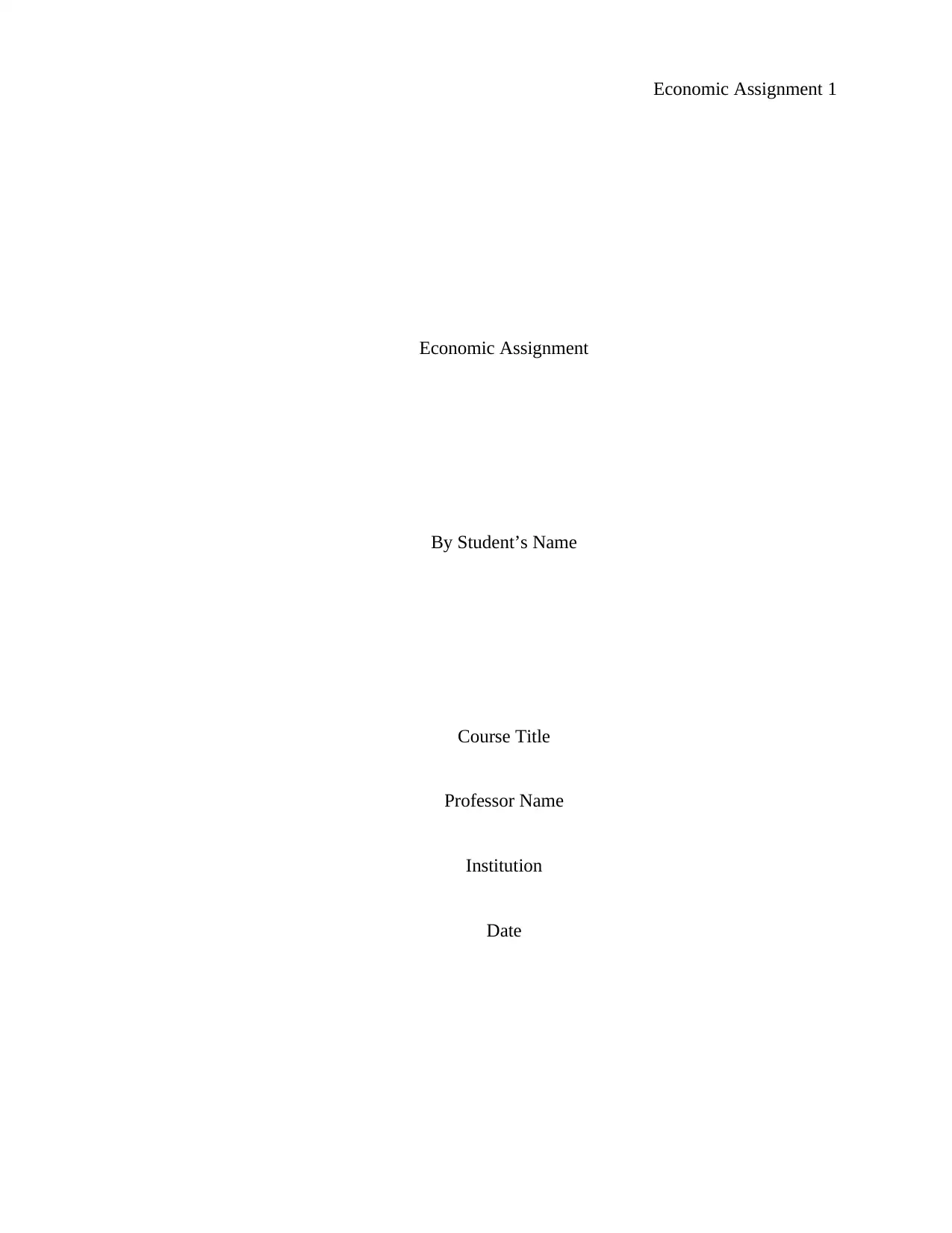
Economic Assignment 1
Economic Assignment
By Student’s Name
Course Title
Professor Name
Institution
Date
Economic Assignment
By Student’s Name
Course Title
Professor Name
Institution
Date
Paraphrase This Document
Need a fresh take? Get an instant paraphrase of this document with our AI Paraphraser
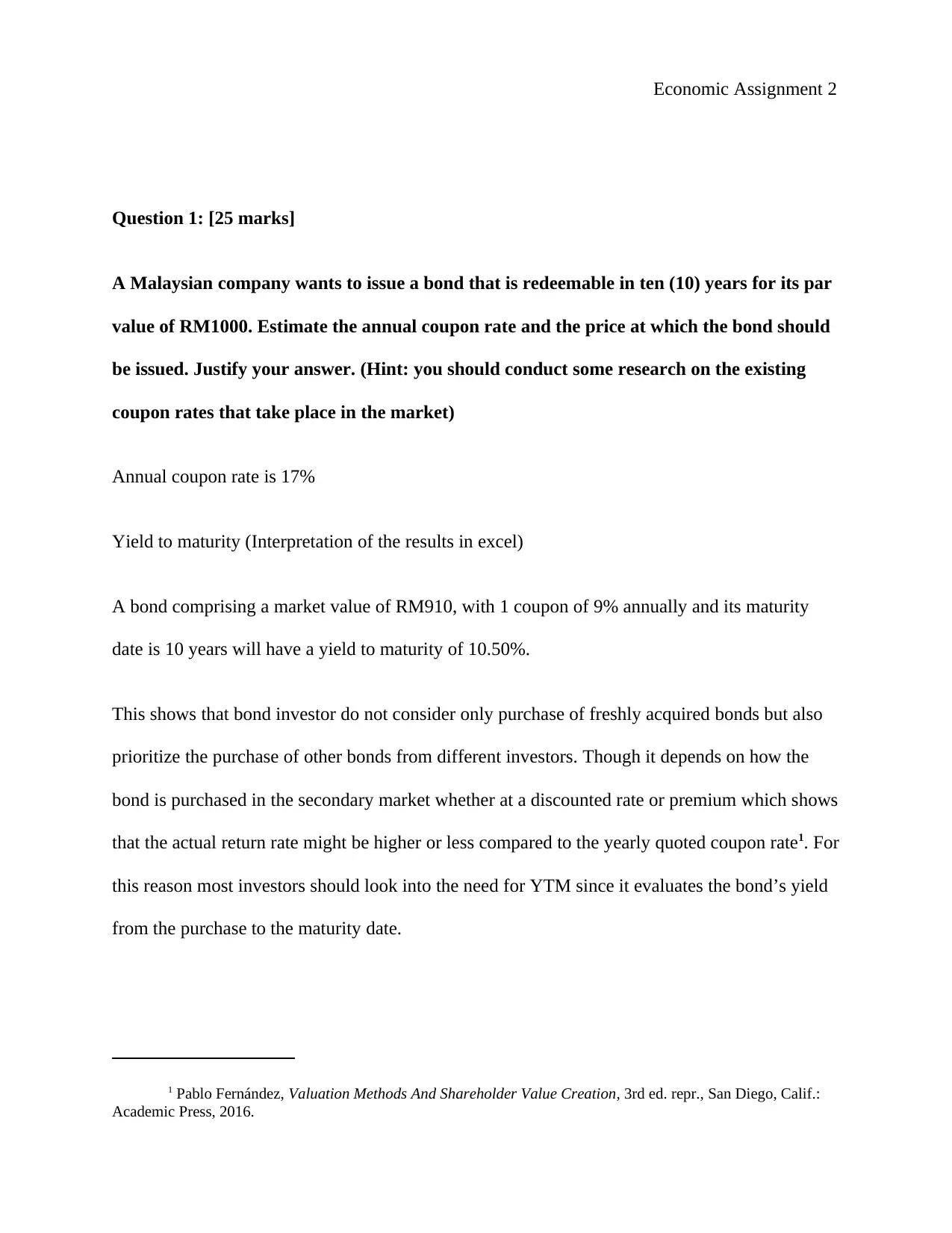
Economic Assignment 2
Question 1: [25 marks]
A Malaysian company wants to issue a bond that is redeemable in ten (10) years for its par
value of RM1000. Estimate the annual coupon rate and the price at which the bond should
be issued. Justify your answer. (Hint: you should conduct some research on the existing
coupon rates that take place in the market)
Annual coupon rate is 17%
Yield to maturity (Interpretation of the results in excel)
A bond comprising a market value of RM910, with 1 coupon of 9% annually and its maturity
date is 10 years will have a yield to maturity of 10.50%.
This shows that bond investor do not consider only purchase of freshly acquired bonds but also
prioritize the purchase of other bonds from different investors. Though it depends on how the
bond is purchased in the secondary market whether at a discounted rate or premium which shows
that the actual return rate might be higher or less compared to the yearly quoted coupon rate1. For
this reason most investors should look into the need for YTM since it evaluates the bond’s yield
from the purchase to the maturity date.
1 Pablo Fernández, Valuation Methods And Shareholder Value Creation, 3rd ed. repr., San Diego, Calif.:
Academic Press, 2016.
Question 1: [25 marks]
A Malaysian company wants to issue a bond that is redeemable in ten (10) years for its par
value of RM1000. Estimate the annual coupon rate and the price at which the bond should
be issued. Justify your answer. (Hint: you should conduct some research on the existing
coupon rates that take place in the market)
Annual coupon rate is 17%
Yield to maturity (Interpretation of the results in excel)
A bond comprising a market value of RM910, with 1 coupon of 9% annually and its maturity
date is 10 years will have a yield to maturity of 10.50%.
This shows that bond investor do not consider only purchase of freshly acquired bonds but also
prioritize the purchase of other bonds from different investors. Though it depends on how the
bond is purchased in the secondary market whether at a discounted rate or premium which shows
that the actual return rate might be higher or less compared to the yearly quoted coupon rate1. For
this reason most investors should look into the need for YTM since it evaluates the bond’s yield
from the purchase to the maturity date.
1 Pablo Fernández, Valuation Methods And Shareholder Value Creation, 3rd ed. repr., San Diego, Calif.:
Academic Press, 2016.
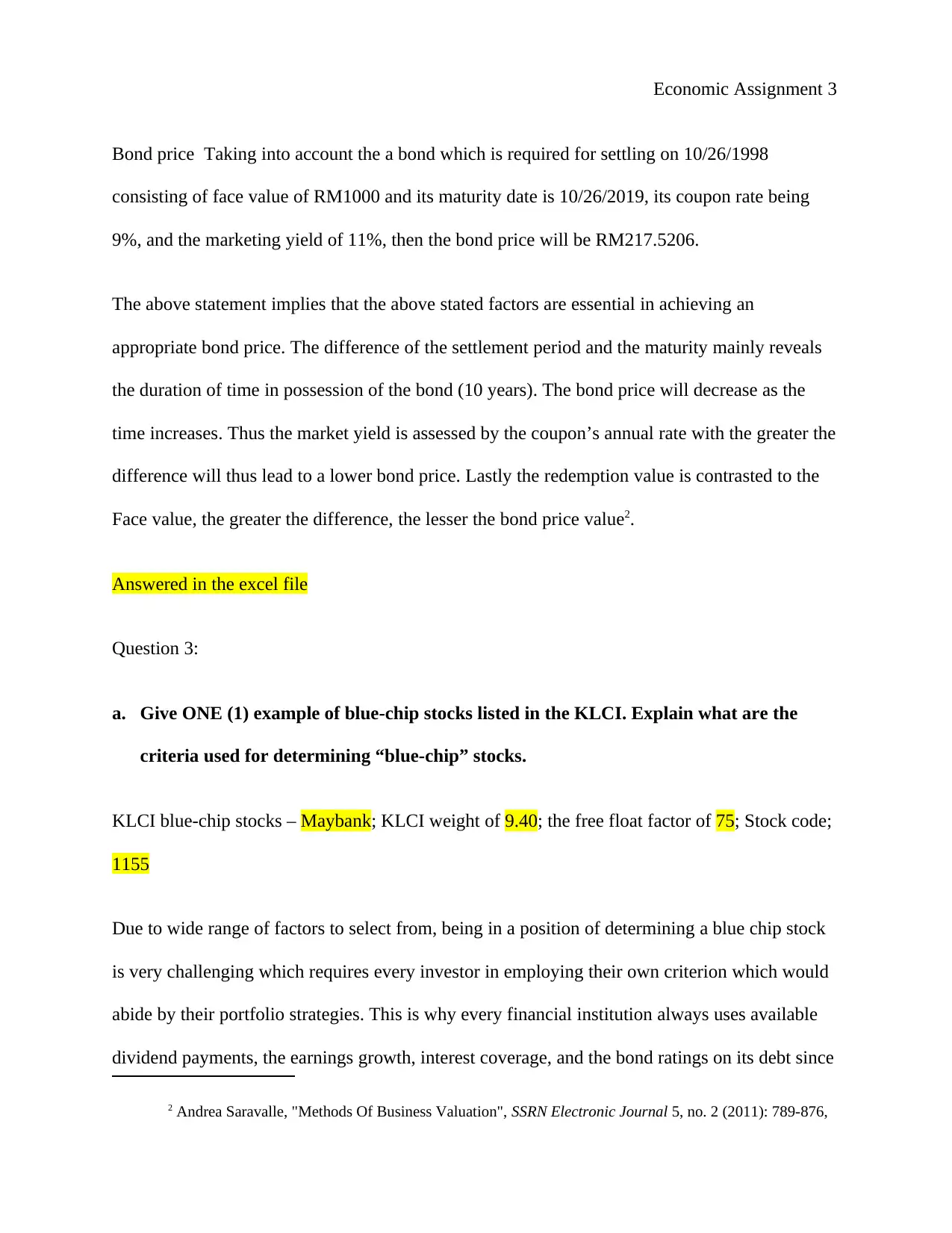
Economic Assignment 3
Bond price Taking into account the a bond which is required for settling on 10/26/1998
consisting of face value of RM1000 and its maturity date is 10/26/2019, its coupon rate being
9%, and the marketing yield of 11%, then the bond price will be RM217.5206.
The above statement implies that the above stated factors are essential in achieving an
appropriate bond price. The difference of the settlement period and the maturity mainly reveals
the duration of time in possession of the bond (10 years). The bond price will decrease as the
time increases. Thus the market yield is assessed by the coupon’s annual rate with the greater the
difference will thus lead to a lower bond price. Lastly the redemption value is contrasted to the
Face value, the greater the difference, the lesser the bond price value2.
Answered in the excel file
Question 3:
a. Give ONE (1) example of blue-chip stocks listed in the KLCI. Explain what are the
criteria used for determining “blue-chip” stocks.
KLCI blue-chip stocks – Maybank; KLCI weight of 9.40; the free float factor of 75; Stock code;
1155
Due to wide range of factors to select from, being in a position of determining a blue chip stock
is very challenging which requires every investor in employing their own criterion which would
abide by their portfolio strategies. This is why every financial institution always uses available
dividend payments, the earnings growth, interest coverage, and the bond ratings on its debt since
2 Andrea Saravalle, "Methods Of Business Valuation", SSRN Electronic Journal 5, no. 2 (2011): 789-876,
Bond price Taking into account the a bond which is required for settling on 10/26/1998
consisting of face value of RM1000 and its maturity date is 10/26/2019, its coupon rate being
9%, and the marketing yield of 11%, then the bond price will be RM217.5206.
The above statement implies that the above stated factors are essential in achieving an
appropriate bond price. The difference of the settlement period and the maturity mainly reveals
the duration of time in possession of the bond (10 years). The bond price will decrease as the
time increases. Thus the market yield is assessed by the coupon’s annual rate with the greater the
difference will thus lead to a lower bond price. Lastly the redemption value is contrasted to the
Face value, the greater the difference, the lesser the bond price value2.
Answered in the excel file
Question 3:
a. Give ONE (1) example of blue-chip stocks listed in the KLCI. Explain what are the
criteria used for determining “blue-chip” stocks.
KLCI blue-chip stocks – Maybank; KLCI weight of 9.40; the free float factor of 75; Stock code;
1155
Due to wide range of factors to select from, being in a position of determining a blue chip stock
is very challenging which requires every investor in employing their own criterion which would
abide by their portfolio strategies. This is why every financial institution always uses available
dividend payments, the earnings growth, interest coverage, and the bond ratings on its debt since
2 Andrea Saravalle, "Methods Of Business Valuation", SSRN Electronic Journal 5, no. 2 (2011): 789-876,
⊘ This is a preview!⊘
Do you want full access?
Subscribe today to unlock all pages.

Trusted by 1+ million students worldwide
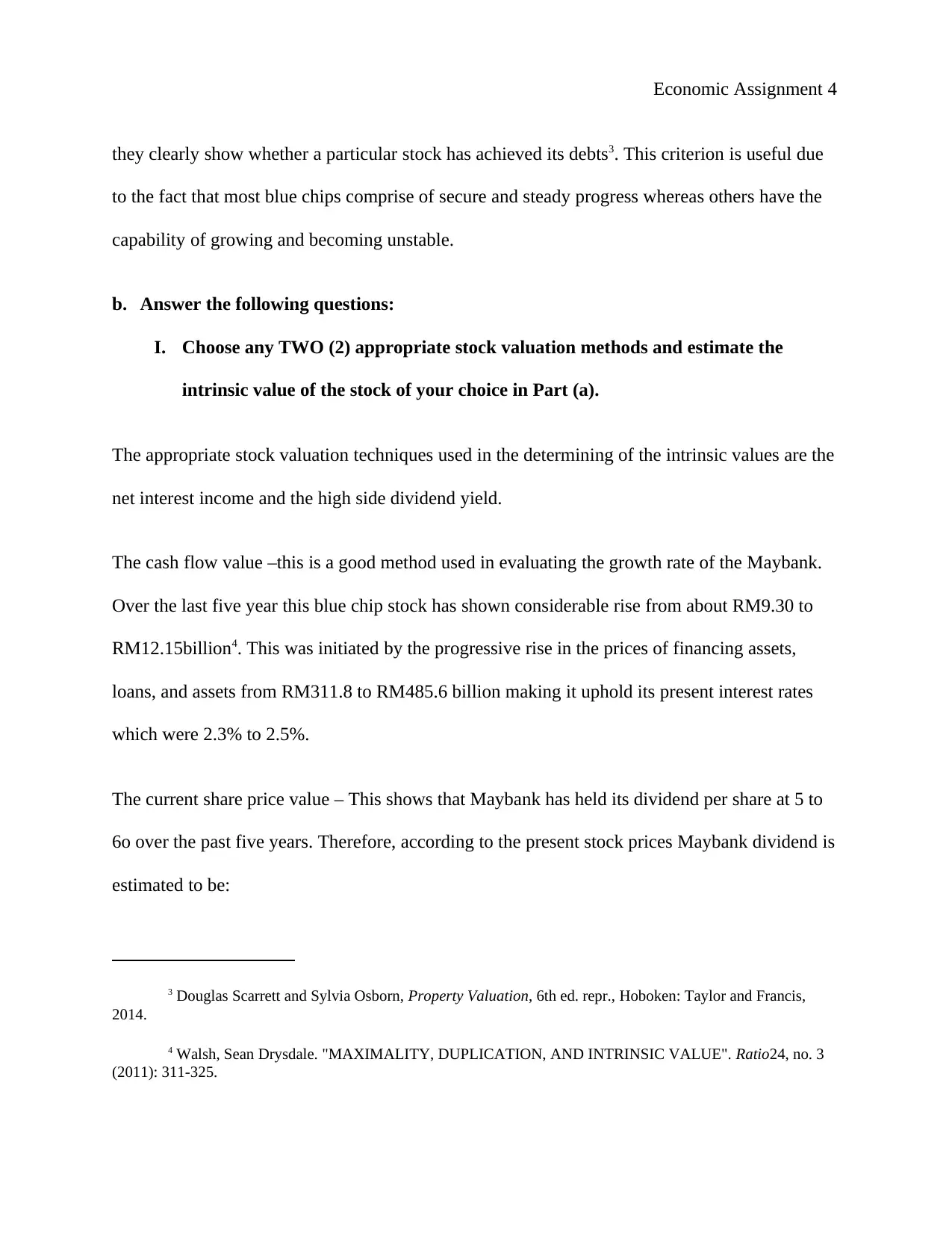
Economic Assignment 4
they clearly show whether a particular stock has achieved its debts3. This criterion is useful due
to the fact that most blue chips comprise of secure and steady progress whereas others have the
capability of growing and becoming unstable.
b. Answer the following questions:
I. Choose any TWO (2) appropriate stock valuation methods and estimate the
intrinsic value of the stock of your choice in Part (a).
The appropriate stock valuation techniques used in the determining of the intrinsic values are the
net interest income and the high side dividend yield.
The cash flow value –this is a good method used in evaluating the growth rate of the Maybank.
Over the last five year this blue chip stock has shown considerable rise from about RM9.30 to
RM12.15billion4. This was initiated by the progressive rise in the prices of financing assets,
loans, and assets from RM311.8 to RM485.6 billion making it uphold its present interest rates
which were 2.3% to 2.5%.
The current share price value – This shows that Maybank has held its dividend per share at 5 to
6o over the past five years. Therefore, according to the present stock prices Maybank dividend is
estimated to be:
3 Douglas Scarrett and Sylvia Osborn, Property Valuation, 6th ed. repr., Hoboken: Taylor and Francis,
2014.
4 Walsh, Sean Drysdale. "MAXIMALITY, DUPLICATION, AND INTRINSIC VALUE". Ratio24, no. 3
(2011): 311-325.
they clearly show whether a particular stock has achieved its debts3. This criterion is useful due
to the fact that most blue chips comprise of secure and steady progress whereas others have the
capability of growing and becoming unstable.
b. Answer the following questions:
I. Choose any TWO (2) appropriate stock valuation methods and estimate the
intrinsic value of the stock of your choice in Part (a).
The appropriate stock valuation techniques used in the determining of the intrinsic values are the
net interest income and the high side dividend yield.
The cash flow value –this is a good method used in evaluating the growth rate of the Maybank.
Over the last five year this blue chip stock has shown considerable rise from about RM9.30 to
RM12.15billion4. This was initiated by the progressive rise in the prices of financing assets,
loans, and assets from RM311.8 to RM485.6 billion making it uphold its present interest rates
which were 2.3% to 2.5%.
The current share price value – This shows that Maybank has held its dividend per share at 5 to
6o over the past five years. Therefore, according to the present stock prices Maybank dividend is
estimated to be:
3 Douglas Scarrett and Sylvia Osborn, Property Valuation, 6th ed. repr., Hoboken: Taylor and Francis,
2014.
4 Walsh, Sean Drysdale. "MAXIMALITY, DUPLICATION, AND INTRINSIC VALUE". Ratio24, no. 3
(2011): 311-325.
Paraphrase This Document
Need a fresh take? Get an instant paraphrase of this document with our AI Paraphraser
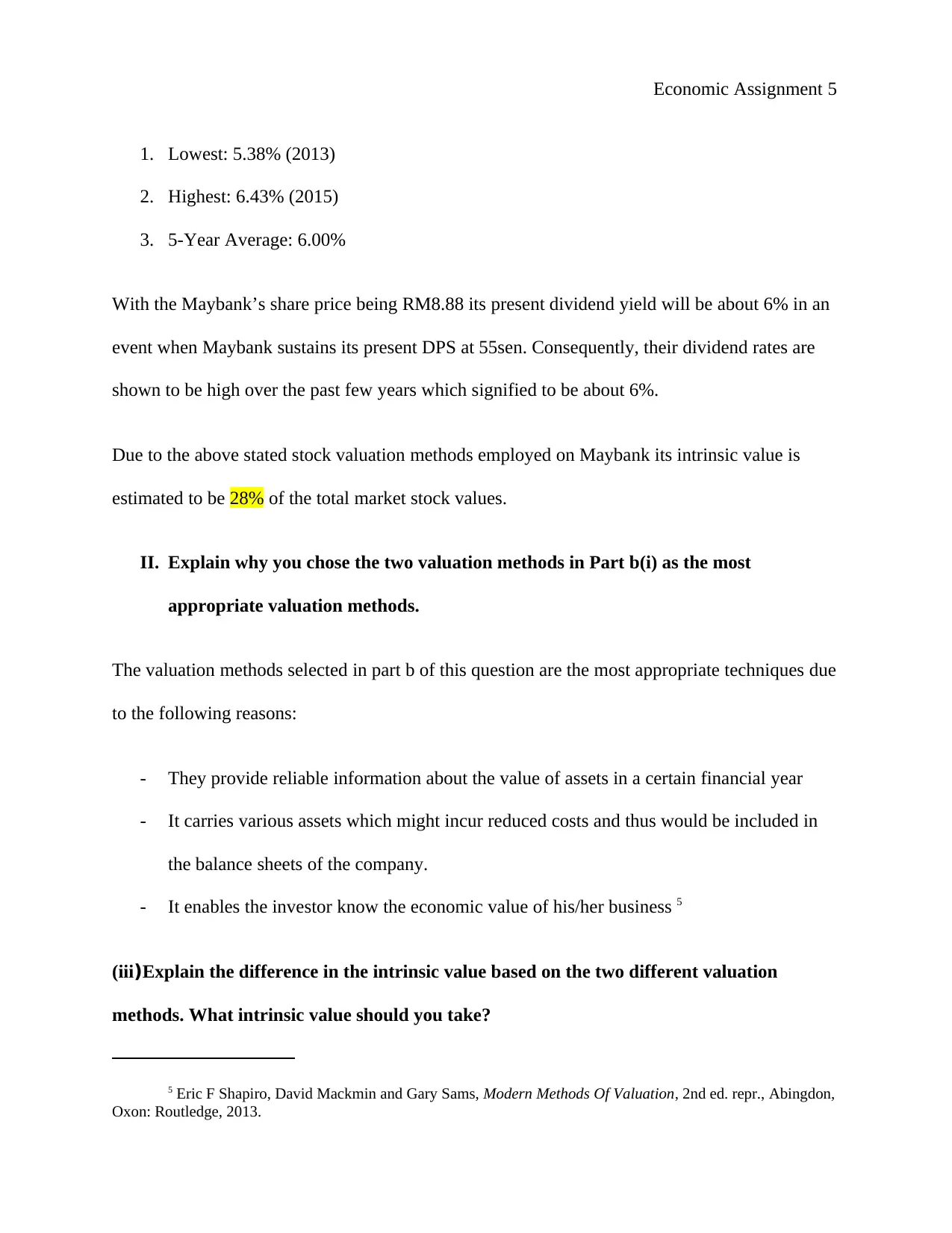
Economic Assignment 5
1. Lowest: 5.38% (2013)
2. Highest: 6.43% (2015)
3. 5-Year Average: 6.00%
With the Maybank’s share price being RM8.88 its present dividend yield will be about 6% in an
event when Maybank sustains its present DPS at 55sen. Consequently, their dividend rates are
shown to be high over the past few years which signified to be about 6%.
Due to the above stated stock valuation methods employed on Maybank its intrinsic value is
estimated to be 28% of the total market stock values.
II. Explain why you chose the two valuation methods in Part b(i) as the most
appropriate valuation methods.
The valuation methods selected in part b of this question are the most appropriate techniques due
to the following reasons:
- They provide reliable information about the value of assets in a certain financial year
- It carries various assets which might incur reduced costs and thus would be included in
the balance sheets of the company.
- It enables the investor know the economic value of his/her business 5
(iii)Explain the difference in the intrinsic value based on the two different valuation
methods. What intrinsic value should you take?
5 Eric F Shapiro, David Mackmin and Gary Sams, Modern Methods Of Valuation, 2nd ed. repr., Abingdon,
Oxon: Routledge, 2013.
1. Lowest: 5.38% (2013)
2. Highest: 6.43% (2015)
3. 5-Year Average: 6.00%
With the Maybank’s share price being RM8.88 its present dividend yield will be about 6% in an
event when Maybank sustains its present DPS at 55sen. Consequently, their dividend rates are
shown to be high over the past few years which signified to be about 6%.
Due to the above stated stock valuation methods employed on Maybank its intrinsic value is
estimated to be 28% of the total market stock values.
II. Explain why you chose the two valuation methods in Part b(i) as the most
appropriate valuation methods.
The valuation methods selected in part b of this question are the most appropriate techniques due
to the following reasons:
- They provide reliable information about the value of assets in a certain financial year
- It carries various assets which might incur reduced costs and thus would be included in
the balance sheets of the company.
- It enables the investor know the economic value of his/her business 5
(iii)Explain the difference in the intrinsic value based on the two different valuation
methods. What intrinsic value should you take?
5 Eric F Shapiro, David Mackmin and Gary Sams, Modern Methods Of Valuation, 2nd ed. repr., Abingdon,
Oxon: Routledge, 2013.
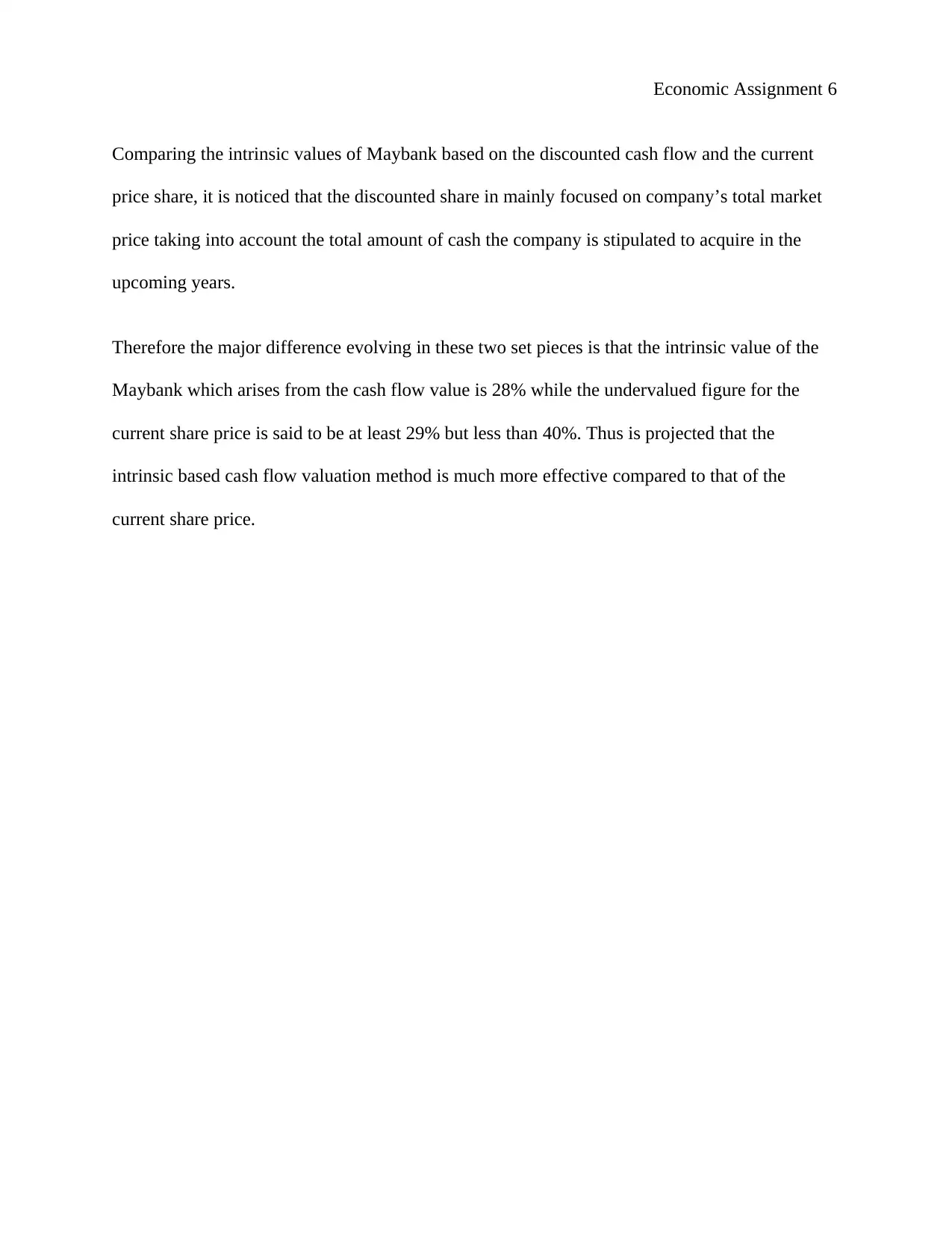
Economic Assignment 6
Comparing the intrinsic values of Maybank based on the discounted cash flow and the current
price share, it is noticed that the discounted share in mainly focused on company’s total market
price taking into account the total amount of cash the company is stipulated to acquire in the
upcoming years.
Therefore the major difference evolving in these two set pieces is that the intrinsic value of the
Maybank which arises from the cash flow value is 28% while the undervalued figure for the
current share price is said to be at least 29% but less than 40%. Thus is projected that the
intrinsic based cash flow valuation method is much more effective compared to that of the
current share price.
Comparing the intrinsic values of Maybank based on the discounted cash flow and the current
price share, it is noticed that the discounted share in mainly focused on company’s total market
price taking into account the total amount of cash the company is stipulated to acquire in the
upcoming years.
Therefore the major difference evolving in these two set pieces is that the intrinsic value of the
Maybank which arises from the cash flow value is 28% while the undervalued figure for the
current share price is said to be at least 29% but less than 40%. Thus is projected that the
intrinsic based cash flow valuation method is much more effective compared to that of the
current share price.
⊘ This is a preview!⊘
Do you want full access?
Subscribe today to unlock all pages.

Trusted by 1+ million students worldwide
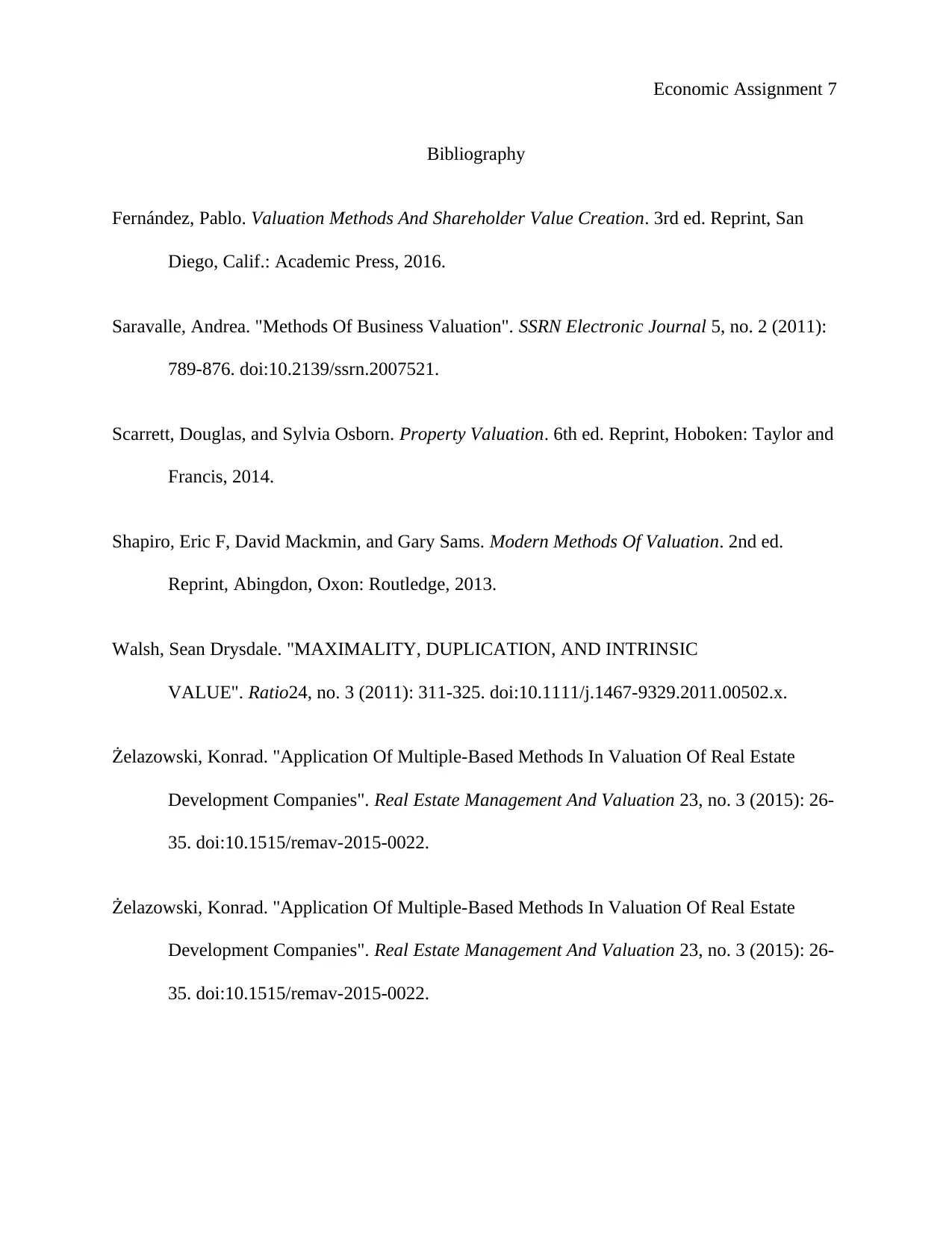
Economic Assignment 7
Bibliography
Fernández, Pablo. Valuation Methods And Shareholder Value Creation. 3rd ed. Reprint, San
Diego, Calif.: Academic Press, 2016.
Saravalle, Andrea. "Methods Of Business Valuation". SSRN Electronic Journal 5, no. 2 (2011):
789-876. doi:10.2139/ssrn.2007521.
Scarrett, Douglas, and Sylvia Osborn. Property Valuation. 6th ed. Reprint, Hoboken: Taylor and
Francis, 2014.
Shapiro, Eric F, David Mackmin, and Gary Sams. Modern Methods Of Valuation. 2nd ed.
Reprint, Abingdon, Oxon: Routledge, 2013.
Walsh, Sean Drysdale. "MAXIMALITY, DUPLICATION, AND INTRINSIC
VALUE". Ratio24, no. 3 (2011): 311-325. doi:10.1111/j.1467-9329.2011.00502.x.
Żelazowski, Konrad. "Application Of Multiple-Based Methods In Valuation Of Real Estate
Development Companies". Real Estate Management And Valuation 23, no. 3 (2015): 26-
35. doi:10.1515/remav-2015-0022.
Żelazowski, Konrad. "Application Of Multiple-Based Methods In Valuation Of Real Estate
Development Companies". Real Estate Management And Valuation 23, no. 3 (2015): 26-
35. doi:10.1515/remav-2015-0022.
Bibliography
Fernández, Pablo. Valuation Methods And Shareholder Value Creation. 3rd ed. Reprint, San
Diego, Calif.: Academic Press, 2016.
Saravalle, Andrea. "Methods Of Business Valuation". SSRN Electronic Journal 5, no. 2 (2011):
789-876. doi:10.2139/ssrn.2007521.
Scarrett, Douglas, and Sylvia Osborn. Property Valuation. 6th ed. Reprint, Hoboken: Taylor and
Francis, 2014.
Shapiro, Eric F, David Mackmin, and Gary Sams. Modern Methods Of Valuation. 2nd ed.
Reprint, Abingdon, Oxon: Routledge, 2013.
Walsh, Sean Drysdale. "MAXIMALITY, DUPLICATION, AND INTRINSIC
VALUE". Ratio24, no. 3 (2011): 311-325. doi:10.1111/j.1467-9329.2011.00502.x.
Żelazowski, Konrad. "Application Of Multiple-Based Methods In Valuation Of Real Estate
Development Companies". Real Estate Management And Valuation 23, no. 3 (2015): 26-
35. doi:10.1515/remav-2015-0022.
Żelazowski, Konrad. "Application Of Multiple-Based Methods In Valuation Of Real Estate
Development Companies". Real Estate Management And Valuation 23, no. 3 (2015): 26-
35. doi:10.1515/remav-2015-0022.
1 out of 7
Related Documents
Your All-in-One AI-Powered Toolkit for Academic Success.
+13062052269
info@desklib.com
Available 24*7 on WhatsApp / Email
![[object Object]](/_next/static/media/star-bottom.7253800d.svg)
Unlock your academic potential
Copyright © 2020–2025 A2Z Services. All Rights Reserved. Developed and managed by ZUCOL.





